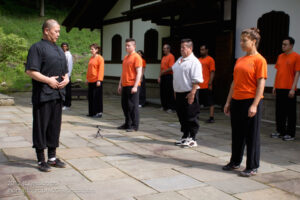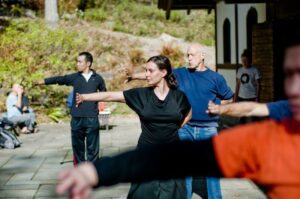
Good respiratory function is important whether you are exercising, meditating or practicing qigong. There are techniques that you can practice to improve the efficiency of your breathing. This will lead to better physical health and mental performance as well as emotional harmony.
Zhuang Tai – Four Categories of Respiration Quality
- Windy/Noisy Breath 风 – This indicates a health problem because healthy respiration should be silent. When inhaling and exhaling through the nose, there should never be any sound. However, when exhaling through the mouth, sound is normal and acceptable.
- Gasping Breath 喘 – The average cycle of an inhale/exhale of our ancestors was longer than that of modern humans. Our shortened breath cycle means that breathing is shallow, the result of a mind overcrowded with thoughts. Not only are we overwhelmed by our daily responsibilities, deadlines, influence from media/entertainment, worries, desires and disappointments, our modern lifestyle is generally far less active than that of our ancestors.
- Regular or Normal Breath 气 – This is the quality of respiration that most healthy people have before beginning to practice breathwork. It is neither bad nor good.
- Purposeful Breath 息 – These are breathing methods practiced to achieve good quality respiration.
Advanced Quality Levels of Respiration
The regular practice of purposeful breathing will result in higher quality respiration and eventually leads to Tai Xi, also known as Primordial Breathing, Embryonic Breathing or Fetal Respiration. The breath slows down to the point of stopping, similar to how a baby breathes through the mother’s respiratory system while in her womb. It should be noted that this is NOT the same as holding the breath and is not a level that you “try” to attain. Practice consistently but do not rush your training. Overthinking creates unnecessary tension that can delay progress. Rather, practice purposeful breathing daily and Tai Xi breathing will come naturally.
There is a caliber of respiration beyond Tai Xi called Qui Xi or “Turtle” respiration. Although very few people attain this very slow, high level respiration in today’s world, it is worth mentioning. It was most commonly achieved by those who live very simple, isolated lives in natural environments similar to monks. Due to a secluded lifestyle, they were able to practice their breathing techniques and meditate throughout the day, every day. Qui Xi is desirable because at this stage, it is believed that the body becomes its own universe and creates everything it needs to sustain itself.
Purposeful Breathing Method息
- Breathing Requirements – At the start of your practice session, set the intention that each inhale and exhale will be deep, long, slow, thin, fine, effortless, even and smooth. This is challenging when you start but diligent practice will bring improvement.
- Bi Xi – Inhale and exhale through the nose. This is when one establishes the rhythm and timing between the inhale and exhale.
- Fu Xi – Always begin and finish the breath cycle in the dantian ( 丹田), the energy field located in the abdomen.
Stages of Progression
- Ti Qi 提气– Inhale to raise the qi from the dantien (in the abdomen) to the chest. This turns on awareness and you enter the “ready” state.
- Chen Qi 沉气– Exhale to sink the qi to the dantian. Awareness is heightened and you enter the “go” state.
- Tuo Qi托气 – After several practice sessions, you will begin to notice that your inhale (to raise qi to the chest) feels smoother, longer and more controlled. At this stage, you should begin holding your qi in your chest. Breath in and out naturally while you keep your qi in your chest. Start with a few seconds and gradually extend the time. Be sure to check the details of your posture (position of hips, chest, shoulders etc) and make improvements as needed. Use a deep exhale to sink your qi when you feel inclined.
- Ju Qi 聚气 – After several sessions of practice, when you have learned to sink your qi, you may begin the step of “gathering” your qi in your dantian. This is done by simply holding your awareness on the dantian before you begin another deep inhale. Check your posture and the position of your hips, feel the fullness in your abdomen. A full dantian is natural design. It is key for a healthy body, focused mind and can prevent energy from being wasted when startled, angered, frightened or surprised.
- Xu Jin 蓄劲–At this stage, the practitioner becomes proficient at storing qi, ready to be used as needed at any time. The qi will go where needed to begin healing like when one cuts a finger are sprains an ankle.
- Fa Jin发劲–This is the outward expression of qi. The qi is converted to jin which is power that is available for use at any instant. We may utilize jin in our martial arts practice. It protects the body and is fuel for recovery. We know that we have reached this stage when the body feels light and thinking becomes clear because qi is flowing smoothly and unobstructed.
Final Thoughts
We do not need to know too much detail to begin practicing purposeful breathwork. Resist the distraction of doing excessive research because you can only gain understanding of this process from personal experience. Too much knowledge can be the biggest cause of blockages to advancement. Rather than taking an overly intellectual approach to this training, it is best to develop wisdom through abundant practice. This way, development will be safer and arrive faster.
The first goal we want to set when we begin training the breath, is harmony between your mind, body and breath. This is the most important building block for further progress.

